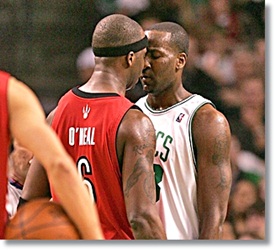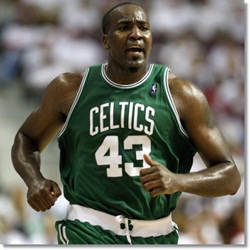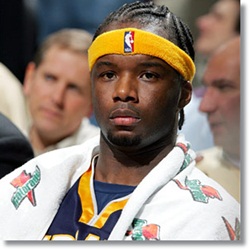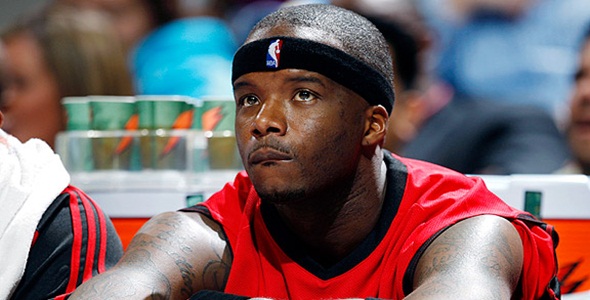With virtually everyone on the Boston Celtics roster back in the fold from their 2010 NBA Finals appearance, except for the retired Rasheed Wallace, the only clear off-season change was the signing of 14 year NBA veteran Jermaine O’Neal to serve as an at least interim starter for the injured Kendrick Perkins. While many of the Boston faithful see the move as an obvious downgrade, I’m here to make the argument that O’Neal is indeed an improvement, especially on the offensive end, and could actually make the Celtics an even better team for the ‘10-’11 season.
 Who knows what could have been if “Perk” didn’t sustain that horrific injury in Game 6, which turned out to be torn ACL and PCL ligaments? Maybe we would be talking about the Celtics newest dynasty winning their 2nd title in 3 seasons. Unfortunately for the green and white, it didn’t quite happen that way, and despite the impressive run we witnessed the Celtics make last post-season, they are back to the drawing board for next year.
Who knows what could have been if “Perk” didn’t sustain that horrific injury in Game 6, which turned out to be torn ACL and PCL ligaments? Maybe we would be talking about the Celtics newest dynasty winning their 2nd title in 3 seasons. Unfortunately for the green and white, it didn’t quite happen that way, and despite the impressive run we witnessed the Celtics make last post-season, they are back to the drawing board for next year.
Now before we get into the specifics, I am a huge Kendrick Perkins fan, right down to the continuous, unwavering scowl, fiery demeanor, and defensive prowess we have all come to love and admire. I do get that Perkins is an extremely popular player in “Beantown” and he is the perfect compliment to both the “Big 4“ and coach Doc Rivers’ tenacious defensive style, but a free agent signing was necessary or fans would have to deal with having Glenn “Big Baby” Davis as their starting “5“ for next season. Not a pretty thought!
Jermaine O’Neal had a nice bounce-back season last year in Miami with numbers in line with his career averages of 14.2 ppg, 7.5 rebs, and 1.5 blocks per game. Although once an elite level NBA player, injuries have clearly taken their toll on the 6 time All Star. Even on this site, he was widely criticized for his lackluster play which led to his untimely trade to Toronto following the ‘08 season, and consequent trade to Miami shortly thereafter.
 When comparing O’Neal to Perkins, they are decisively different players. The Celtics should be a decidedly better offensive team with O’Neal starting at least the first 50 games. The Celtics ranked only 15th during the regular season in offensive efficiency, which is obviously an area that needed improvement if they are to win another NBA Title. Although Perkins was an NBA 2nd best in FG%, while shooting 60%, all or most of his points came within the painted area or on dunks. O’Neal shot a career high 53%, with roughly 2/3rds of his shots taken in the mid-range area(16-23 feet). Out of those mid range shots, he made 44% of his shots, which puts him right on par with his new Boston teammates Ray Allen(45%) and Kevin Garnett(46%), who is arguably one of the best big shooting big men ever.
When comparing O’Neal to Perkins, they are decisively different players. The Celtics should be a decidedly better offensive team with O’Neal starting at least the first 50 games. The Celtics ranked only 15th during the regular season in offensive efficiency, which is obviously an area that needed improvement if they are to win another NBA Title. Although Perkins was an NBA 2nd best in FG%, while shooting 60%, all or most of his points came within the painted area or on dunks. O’Neal shot a career high 53%, with roughly 2/3rds of his shots taken in the mid-range area(16-23 feet). Out of those mid range shots, he made 44% of his shots, which puts him right on par with his new Boston teammates Ray Allen(45%) and Kevin Garnett(46%), who is arguably one of the best big shooting big men ever.
While “Perk” is obviously a better one-on-one, back to the basket, low post type player, O’Neal is much more diverse, which bodes well in likely pick-and-roll situations usually reserved for Garnett. So when KG’s knees are aching, or when he picks up his 3rd foul in the first half of games, Jermaine is an able bodied replacement in the offense.
Another stark difference is at the charity stripe. Like kryptonite to Superman, Perkins more than anywhere else on the court has issues shooting free throws. As a starter, Perkins has never shot higher than .615%, even dipping to a devastating .582% last season. To be quite honest, that is nearing Shaq territory and consequently he becomes a liability late in games. In contrast, Jermaine O’Neal has worked hard at his free throw stroke and has a career average of .711%, even once sinking more than 80% in a season once in his career. That could equate to nearly 5 points per game and becomes especially important down the stretch in 4th quarters of games.
 Most people don’t even look at turnovers when it comes to evaluating NBA big men. But in this case, it’s warranted since Perkins statistically was the most turnover prone center in the league while O’Neal ranked near the bottom. O’Neal was remarkably efficient, committing a turnover on just over 12% of possessions last season where Perkins turned the ball over on more than 20% of possessions. That’s on average, 1 turnover every 5 times he touched the ball, although it is not clear how many of those dreaded illegal screen calls he was prone to were considered turnovers. With turnovers being the Celtics’ Achilles heel last season, an improvement will do wonders for the flow of offense.
Most people don’t even look at turnovers when it comes to evaluating NBA big men. But in this case, it’s warranted since Perkins statistically was the most turnover prone center in the league while O’Neal ranked near the bottom. O’Neal was remarkably efficient, committing a turnover on just over 12% of possessions last season where Perkins turned the ball over on more than 20% of possessions. That’s on average, 1 turnover every 5 times he touched the ball, although it is not clear how many of those dreaded illegal screen calls he was prone to were considered turnovers. With turnovers being the Celtics’ Achilles heel last season, an improvement will do wonders for the flow of offense.
Even though he slipped to a career low 1.4 blocks per game last season, O’Neal remains a more athletic player and should at least alter a few more shots as the starting center in Boston. Perkins’ swatting 1.7 per contest isn’t to shabby but O’Neal still has a reputation of being an elite level shot blocker, who took away 2+ shots per game for a 10 year stretch, ending just 2 seasons ago. Again, as a one-on-one defender, Perkins has the edge since he is arguably the only player in the league who can guard Dwight Howard without the help of a double team.
In conclusion, although we cannot measure all of the intangibles of not having big “Perk” in the line-up until after the All Star break, the Celts will be in good hands with Jermaine O’Neal holding down the fort at the center position. Maybe if the rest of the Celtic roster can remain healthy through the regular season, Jermaine can help them be a more diverse offense by shoring up their deficiencies, the Celtics can finally hang that elusive 18th championship banner that they had plans on winning last season.
Allen Moll has been a lifelong NBA and NCAA College Basketball fan who watches and studies games religiously, and coaches youth basketball in his native Lehigh Valley region of Pennsylvania. Allen also provides content to Bleacherreport.com, Upperdeckblog.com, in addition to being a tenured NBA and NCAA columnist for TheHoopDoctors.com.
















